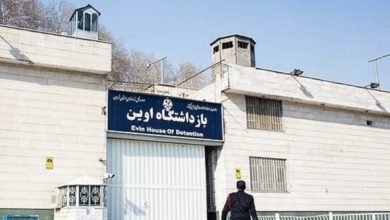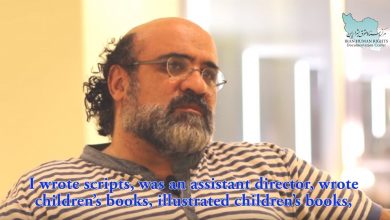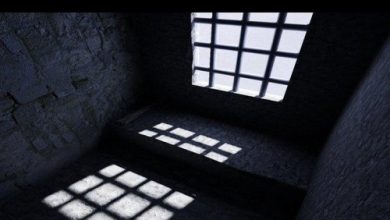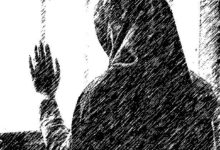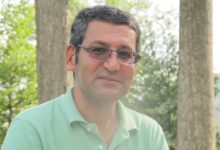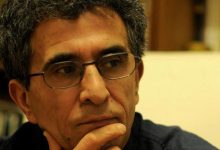Witness Statement: Shahram Rafizadeh
Shahram Rafizadeh is a poet, investigative journalist and blogger. On September 7, 2004, Rafizadeh was arrested allegedly because of his writings for Gooya News and Emrooz, two well-known reformist websites. He was held in solitary confinement for 73 days in an unknown detention facility. In this witness statement, Rafizadeh describes formation of parallel intelligence agencies, his arrest and mistreatment in prison, and his forced confession.
Full Name: Shahram Rafizadeh
Date of Birth: September 11, 1970
Place of Birth: Gilan, Iran
Occupation: Journalist and Poet
Interviewing Organization: Iran Human Rights Documentation Center (IHRDC)
Date of Interview: September 12, 2008.
Interviewer: Habib Rahiab
Witnesses: None
This statement was prepared pursuant to a telephonic interview with Mr. Shahram Rafizadeh. The statement consists of 52 paragraphs and 12 pages. The interview was conducted on September 12, 2008. The statement was approved by Mr. Rafizadeh on February 26, 2009.
Witness Statement
Preface
1. My name is Shahram Rafizadeh. I was born in Gilan and I recently celebrated my 38th birthday. I studied mathematics, but in reality I am a poet. In 1993-94, I started my work in publishing and editing, and in 1996-97, I began my career as a journalist. My first job as a journalist was working for Iran Javan. I worked in the poetry and literary section. I also spent some time working for the cultural section of Iranian newspapers.
2. After the Chain Murders in 2000, I began engaging in political journalism and coauthored a book with Nima Tamadon about assassinations in Iran. This book examines the history of assassinations in Iran. Later I wrote three books regarding the Chain Murders. The first volume was entitled The Power Game and received permission for publication from the Islamic Republic’s Ministry of Islamic Culture and Guidance. But the next two volumes, which were entitled Power Game and The Death of Power didn’t receive permission for publication.
3. I was arrested in 2004 by the Parallel Intelligence Apparatus and charged with blogging and writing articles for websites such as Gooya News and Emrooz, both of which are reformist sites. I was detained for 86 days, 73 of which were spent in solitary confinement. I spent the last 13 days in Evin Prison. I was finally released after seven or eight court sessions which convened in Mortazavi’s office. In 2005, I left Iran and am currently a resident of Toronto.
What is the Parallel Intelligence Apparatus?
4. “Parallel Intelligence Apparatus” is a term which appeared during the reformist period and referred to a collection of intelligence and security government agencies which were under the control of the conservatives and operated outside the jurisdiction of the government of Mr. Khatami. The term “Parallel Intelligence Apparatus” entered the political lexicon around 1997-98, and political activists began to acknowledge its existence after witnessing the operations of the intelligence and security agencies.
5. The Parallel Intelligence Apparatus (PIA) began its operations after it was revealed that [at least some of] those responsible for the Chain Murders were connected to the Ministry of Intelligence, resulting in the purging of several rightwing elements within the ministry. The Intelligence Protection Organization of the Revolutionary Guards, the Intelligence Protection Organization of the Law Enforcement Forces and the Intelligence Protection Center of the Judiciary (in cooperation with Judge Mortazavi and several writers connected to Kayhan newspaper) composed the principal administrators of the PIA. Individuals within this apparatus worked according to their area of specialization. For example, the investigative interrogators were mainly educated intelligence operatives from the Ministry of Intelligence; Kayhan employees provided the political direction to the interrogators; and Tehran’s Prosecutor and individuals within the Judiciary who were allied with the previous groups provided legal cover for the unlawful actions of the PIA.
6. The PIA worked on a project-to-project basis. The goals and composition of each project is predetermined. Each project included three phases: identification [of targets], investigation and propaganda. In these projects cases were initiated based on trumped up charges and ended when the arbitrary objectives [of the PIA] were satisfied. Arrest warrants were illegally issued after the actual arrests. The objective of the “students project” was to secure television confessions from Ali Afshari and the victims of the University [of Tehran] dormitory. The objective of the “cinema project” was to secure confessions from Siamak Pourzand. [The objective of the census case (launched in 2002) was to go after Abbas Abdi and Hossein Ghazian. And last but not least, the goal of the “bloggers and journalists” project was to silence the demands of the reformists.
7. The PIA had lots of resources at its disposal and took advantage of these resources in cunning fashion. The PIA had its own judges, such as judges Haddad and Saber Zafarqandi (the judge of the Special Court at Mehrabad Airport in Tehran). They had their own prosecutors such as Mortazavi, the General Prosecutor of Tehran. They had their own secret detention facilities such as Prison 59 and Towhid. They also had their own individuals inside the Law Enforcement Forces and Revolutionary Guards who acted as “officers of the court” and were entrusted with the authority to arrest anyone they wished. And finally, they had their own experienced intellectuals and theoreticians – Shariatmadari, the Chief Editor of the newspaper Kayhan, and Hassan Shayanafr – who provided direction to the organization and were responsible for drafting the interrogators’ questions. These individuals used their own methods to fabricate case files, torture [their victims] and secure arbitrary confessions out of their detainees. They then used these confessions to promote their own agenda and crush the reform movement.
8. The division of labor within the PIA was based on the subject at issue and was well-calculated to compensate for the weaknesses of individual members of the group. If one group did all the work, it could expose and subject itself to scrutiny. In addition, this division of labor allowed the PIA to use the most beneficial and appropriate channel depending on the specific case at issue. The PIA relied on different resources for different objectives – a strategy which insulated it from exposure. For example, when it came to acting against students, workers and trade guilds (which were often used by political activists), [the PIA] relied on the Revolutionary Guards. They used the Law Enforcement Forces under the supervision of the Amaken office in order to go after journalists, intellectuals, writers and artists.
9. The Office of Supreme Leader has its own Intelligence Protection Organization which is headed by an individual by the name of Hijazi.
10. The PIA was not a unified or official intelligence organization – it was a coalition. Different intelligence agencies that were engaged in the struggle against the reformists were part of this coalition. I have yet to come across an official document indicating that the PIA was established pursuant to the orders of the Supreme Leader or the head of one of the intelligence agencies within the government. Notwithstanding its collective makeup, the PIA operated in a systematic, coordinated and strategic manner.
11. For example, the PIA held regular sessions in the detention facilities in which I was imprisoned. We heard the sounds of numerous vehicles that came and parked there. After these sessions ended, we knew that important decisions had been made about our case files. The interrogators would ask us new questions and we realized that they wished to take our cases in a different direction.
12. The PIA’s [regular] interrogators were often not as educated, trained, or experienced as those linked to the Ministry of Intelligence. Their method of extracting confessions usually required torturing detainees. The interrogators asked predetermined questions and expected the detainees to give answers consistent with their wishes. If the detainee failed to provide the preferred answer, the interrogators would attack and beat them. Often times [they simply acknowledged the obvious: “This is what we want. You have to either say it or write it down.”
13. Interrogations conducted by the PIA were not based on logic but on acting out a scripted scenario. When they managed to break the detainee, they’d calmly tell him “we want you to play your role in [our] scenario.”
14. For example they told me “we’ve caught you – you have security-related charges. We will use you for a political purpose. If you confess to what we designated exactly as it appears in the scenario and you play the role, you will be released. Otherwise, you will stay here and rot.” Explicitly, bluntly and shamelessly they told me “we have bigger goals that are not limited to you. We caught you due to your work experience.” Then they listed the special reasons that showed how I fit into their scenario, such as my work and family situation and my social and political backgrounds.
15. PIA activity has apparently decreased in Tehran. This decrease does not, however, indicate the end of the PIA. In fact, the PIA is in the process of replicating its history of success against the reformists in Tehran in other cities. Most of the activities of the PIA are currently concentrated in insecure areas such as Sistan- Baluchistan, the Kurdish areas, and southern areas populated by ethnic Arabs.
16. The PIA did not have a uniform method for dealing with detainees. Their treatment of a detainee who was “one of them” (i.e. those who were regime insiders) was, to a certain degree, lenient if not generous. This is not to say that they did not resort to violence against these individuals, but that the violence and its consequences were less severe than that which was used against other detainees (i.e. those who were not regime insiders).
The History of Secret Prisons in Iran
17. The history of secret, special or hidden detention facilities inside the Islamic Republic of Iran goes back to the days of the Islamic Revolution. It goes back to the establishment of Islamic revolutionary committees, the Basij, the Revolutionary Guards, and the confiscation of the residential areas and homes of those opposed to the Islamic Revolution. These Islamic committees and armed groups who supported the new Islamic government, such as the Mujahedin-i Khalq and the Feda’in-i Khalq, confiscated the homes of these government dissidents and used them as detention facilities. There was no rule of law in these detention facilities, and those responsible answered to no one. Torture and forced confessions were common interrogation and investigation methods used in these detention centers. This deplorable method of interrogation is a continuing legacy [of this era].
18. Although with the establishment of the Ministry of Intelligence in 1984 a series of detention facilities which were located in confiscated homes came under the control of the ministry, the culture of torture and its concealment did not disappear. The Ministry of Intelligence continues to use some of these homes as intelligence centers, and others as temporary and secret detention facilities. In addition, the residences that were confiscated by the Revolutionary Guards and Basij remained under the control of these forces. Anyone who visits these secret detention facilities realizes that they are, in fact, residential homes. One of these secret facilities, which was located in western Tehran and was used by an intelligence group under the command of Emami (a deputy head at the Ministry of Intelligence during the time of Fallahian) was a building which was located in the middle of a residential area. But Emami used it as a detention center.
19. There are lots of these types of detention facilities in Iran. The State Prisons Organization (SPO) submitted a report to Majlis in 2006-07 regarding the closure of more than 100 of these secret prisons. The Iranian Students News Agency also reported the existence of more than one hundred of these secret detention facilities in 2006-07. In addition, the special commission (headed by Ali Akbar Musavi- Khu’ini) established to inspect the condition of secret facilities in Tehran reported on the existence and closure of secret prisons that were administered by the PIA. Only portions of this report were ever made public.
20. After the case of bloggers created a lot of news and almost all the arrested individuals complained about the torture in secret prisons, Hashemi Shahroudi created a committee by the name of “Committee for Executing the Civilians’ Laws” under the supervision of Alizadeh and made him carry out a research on the secret prisons. In his report to the head of Judiciary, Alizadeh announced his “inability to access some of the prisons” that were under the protection of the Intelligence Office of Revolutionary Guards. The Revolutionary Guards had told Alizadeh that they work directly under the Supreme Leader and the Ministry of Justice does not have the authority to investigate the centers of that organization.
21. In Iran, investigating the [existence] secret detention centers is dangerous business. Even though semi-independent outlets provided patchy reports regarding the existence of a series of secret detention facilities during Khatami’s time, those who persistently followed up on this issue paid a hefty price. An example is Alizadeh, a conservative person and one of the renowned religious figures who was responsible for the large scale closures of newspapers and the silencing of journalists in 2000, was demoted for investigating the case of secret prisons.
Why did they Arrest Me?
22. My interrogators told me that arrests are made after an investigative committee conducts investigations, analyzes case files and reaches conclusions in light of the organization’s larger political goals. I don’t know what factors they take into account but I am certain that these methods exist.
23. I had written three books in early 2001 (which I previously referred to) which included sharp criticism, but I was arrested on September 7, 2004. I kept asking myself why I was arrested then, especially because I had not written even one article during the ten moths prior [to my arrest]. They (members of the PIA) knew that I had not written anything [in months]. I had not written anything because I had really grown tired of Khatami’s reformist promises. Not only had I lost hope, but I was certain that Khatami was not committed to the reform movement and that his slogans were nothing more than smoke and mirrors.
24. The day I was arrested I was working at the newspaper’s office. One of my colleagues said that someone had come to talk to me. When I went down, I saw a young guy waiting for me. He didn’t look like a Hizbullahi.1 When we sat to talk, he showed me a summons. I looked at the date on the summons, and realized that it had expired. I complained and informed him that the summons indicated that I should go to the Amaken office on September 5th at 3:30 p.m. The young man apologized and said it was an unintentional mistake. He then told me to go to Amaken’s office at 8:30 the next day. I accepted. He said goodbye and left.
1 Hizbullahi is a generic term used to describe individuals either loosely or directly affiliated with Islamist pressure groups (i.e. Ansar-i Hizbullah or the Basij) or government agencies such as the Law Enforcement Forces.
25. About forty minutes passed and again one of my coworkers told me that the same person who had come to see me before had summoned me again. I became worried. The young man told me that one of the senior officers had personally come to see me and answer my questions. He added that I should walk outside [to see the officer] and ask him questions, and return after I’m done. I told him to go and said I would visit Amaken’s office the next day. He insisted that I should go with him now, so that I could resolve my legal issues. I insisted that he tell me if I was under arrest or would be arrested so that I could tell my brother and coworkers at the office what needs to be done in my absence. In response he said, “No, no, there is no need for that. It will only take 10 minutes – you can return to work after that.” I said, “Please tell your senior officer to come here.” He said, “No, he can’t. You have to come with me. If you refuse you will definitely be arrested.”
26. As I was leaving the office a man told me to follow him because I was under arrest. I resisted, but he showed me his gun and handcuffs. He took my hand. I realized that I had seen this man somewhere before.
27. Several of my coworkers and friends were standing in front of the newspaper office’s gate. One of them tried to write down the car’s license plate, but one of the officers got out of the car and angrily tore up the piece of paper. He advised my friends that the arrest was legal and there was no need to write down the car’s license plate.
The Secret Prisons
28. From the office they took me to Amaken. I stayed there for a while until they put me in a car (without tinted windows) and returned me to my home so they could search it. They confiscated all my papers and documents, along with my writings, as “evidence of a crime.” During the search I noticed two pocket-sized books titled Code of Criminal Procedure and Iranian Constitution. I asked the agents if I could take them along with me because I thought I’d need them, but they said I would have no need for them since I would be released soon. After they searched my home they returned me to Amaken’s office.
29. In Amaken they forced me to change cars. They sat me in the back of a black car that had curtains. They talked to each other for a while. Then one of them hit me from behind and said, “Put your head down.” Their attitude suddenly changed. They blindfolded me and took me to a different location. I think we entered a courtyard. We passed a corridor on the left side of the courtyard and they took me into a house that appeared to be a detention center. They took my glasses, belt and shoes away. A metal door opened and they threw me in a cell. The cell was very dark. It had a large vent. I stayed there for about two hours. I could hear strange noises but couldn’t tell what they were.
30. I was blindfolded. They handcuffed and dragged me to a chair. A low voice asked me, “Do you know where you are?” I said, “No.” The voice said, “[You are] in the miracle room.” I grinned. “The Miracle Room” was the name of one of the articles I had written. It wasn’t long until a bunch of people started punching and kicking me. I was blindfolded, and couldn’t see how many they were. I don’t know how long it lasted. After they beat me, I fell unconscious for some time. They carried me to the restroom. They sprayed water on my face and I regained consciousness. I washed my face and I noticed that my nose was bleeding. When I washed my nose in the bathroom, my entire hand was covered in blood.
31. During these continuous interrogations, I was constantly beaten up. The interrogations never let up. They were conducted at all hours, all the time. They always wanted me to give in to their demands and act out the written script they had prepared for me. Sometimes during the interrogations they would push my forehead into the wall. They smashed my head against the wall a couple of times. I screamed from the pain but they wanted me to submit to their demands. During these torture sessions, anything could have happened to me. I could lose an eye. My nose could break, or I could have suffered from breathing complications as a result of the repeated blows to my head and forehead. They had slapped and punched my face so many times that my face had gone numb.
32. Physical beatings did not only include punching and kicking. Once they smashed a wash bowl that was in the interrogation room on my head. On other occasions they whipped my back and feet with cable wires. When I resisted, they whipped me all over – on my on my back, butt, and legs – all the way down to my heels. I don’t know how many times they whipped me. It varied. Sometimes they hit me ten times, sometimes twenty or thirty, and other times more. There were short pauses between the torture sessions, during which the interrogators asked more questions. If they didn’t get the answer they wanted, the torture continued.
33. Emotional torture regularly accompanied physical torture. The emotional torture varied, usually beginning with threats to me and ending with threats against my family. For example, they threatened to arrest my father and torture him in my presence, or they said that I have an adorable family and that I shouldn’t do anything to lose them for good. Anything was possible. They threatened to kill my family in a planned traffic accident – hundreds of traffic accidents happen in Tehran every day. This could have been just another one of them. But the worst threats were directed against my wife. They said, “We will arrest and bring your wife here, and you know what will happen to her next.” The thought sent shivers down my spine. They were savages, and capable of anything.
34. When I collapsed from the physical and psychological torture, they said, “Take him away until he comes to again.” When I regained composure, the whole thing would start all over again. The beatings, the cable wires, the insults and threats – they started again, but this time with more viciousness.
35. Usually, during the torture sessions they turned on an air ventilator that created a dreadful sound. This machine was located above the cells. The machine’s loud noise doubled the prisoners’ physical and psychological anguish and drove them insane. How long can a person listen to a grating noise? Five minutes? Ten minutes? An hour? But this noise continued on for eighteen hours straight. During this time the prisoners couldn’t communicate. They wouldn’t hear each others’ voices. This noise also drowned out the groaning of the detainees during their torture sessions.
36. For a while I didn’t even know why I had been arrested, until I realized that most of the detainees were bloggers, information technology employees and website designers. Some of the others had been arrested and detained because they had reproduced and published banned books. I was the only one among them who had actually written articles on bogs. This is how I discovered that they had arrested me for my blogging activities.
Interrogation Sessions
37. During the first 30 to 40 days, the interrogation and torture continued nonstop. I spent most of this time in the interrogation room. They didn’t allow me to return to my cell. They wanted to beat me up, whip me and torment me so I would break and surrender. The physical torture continued until I broke. As soon as I broke, the frequency of torture lessened, and the interrogations shifted to bargaining over what I should confess to either verbally or in writing. I think it was during the 26th and 27th day that I finally submitted to the interrogators and could no longer resist. I stayed there for 73 days. Afterwards, they transferred me to Section 240 of Evin Prison, which was under the control of the Intelligence Protection Organization of the Judiciary.
38. Our detention facility had two sections. One was an administrative section and the other a detention facility. The administrative section was located on the right side, and hidden from view with curtains. The only way to enter the detention facility was to go through this administrative area. On the left side there were two rooms which were separated by an iron door. A narrow hallway passed between them. On each side of the corridor there were nine solitary cells, each measuring a meter and a half long and a meter wide. The cells were so small that you couldn’t turn around inside them. If you were facing one way and wanted to turn around, you had to walk backwards. A green light was located outside the cell. The cell itself was dark, and the light outside was not strong enough to brighten the hallway. (The light in the hallway was changed after the detainees complained that it was too dark.) The top half of the cells had a window which was covered by iron bars. [The door] had a small slot which was used to deliver food.
39. The interrogation rooms were at the end of a narrow hallway. There were six of these rooms. The walls of these rooms were covered with white film that prevented those inside the interrogation room from seeing individuals on the outside. Individuals who were outside the interrogation rooms could, however, observe and monitor the actions of the detainees. There was a table inside the interrogation room with a telephone on top. They sometimes allowed us to use the telephone to contact our family members. But we knew that our conversations were being recorded. I was only able to communicate with my family during 4 of the 73 days which I spent in solitary confinement.
40. On one end of the [interrogation] room there was a video camera which was turned off when the detainee was being tortured. I only became aware of all these deceitful activities after I had been broken and forced to confess. My interrogators asked me questions for hours on end – sometimes for 5 to 6 hours. During this time the camera was turned on, but as soon as things got a little heated they would turn it off. The camera was also turned off when I was forced to engage in those unbearable free writing sessions.
41. Those who interrogated us usually had fake names. We were never able to determine their real identities.
42. I wore the same clothes during the entire duration of my detention. My outfit consisted of a short-sleeved shirt with pants and an undershirt. My clothes were extremely dirty, and I asked the custodian to allow me to wash my clothes. Only once did they allow me to wash and dry them in my solitary cell.
43. They allowed us to use the restroom (and conduct ablutions [for daily prayer]) three times a day. These visits were very short and lasted for about 3 minutes. They required us to perform the ablutions every time.
44. In the bathroom there was a disconnected washing machine which was apparently used to eavesdrop on the conversations of detainees (in those rare instances where several detainees were allowed to use the restroom at the same time).
Forced Confessions
45. The free writings were, in fact, a way to trap the detainees. They were the first documents used against the accused. The interrogators questioned each sentence written and posed new questions based on the answers we provided. They questioned every aspect of our lives, and ruthlessly violated our personal and private space. Then they used the information they gathered to defame us. Most detainees broke during this period, and gave into the wicked schemes designed by the interrogators. For example, they usually asked us if we knew a particular person of the opposite sex. If you say “no,” they torture you. If you say “yes,” they have you because such an admission is the beginning of your troubles – it ultimately leads to a false accusation regarding an illicit sexual relationship. After that they tell you that they prefer not to expose your sexual relationship, but that they will only do so if you agree to play your role in their scenario. In this way, free writings and the questions that accompany them led the way to the specific charges against you.
46. When I surrendered, they asked me to prepare myself for a confession on TV. At this point all my facial bruises had healed. This was a part of their plan all along: the physical torture continued until the accused surrendered. Once that happened, the investigations, free writings and case file manipulations (which were psychological in nature) began, and continued until the individual [was] ready for a TV confession. At that point there were no signs of physical torture left on his body. There were, of course, some visible signs of abuse. For example, the prisoner appeared sickly and malnourished. He had a thick and untidy hair. When they videotaped me, my weight had dropped from 95 kilograms to 45 kilograms. There was no meat left on my bones and my finger and toe nails were very long.
47. I had strong suspicions that they put drugs in our food. I hallucinated often – I’d see myself in the middle of the road, or in the midst of people who wanted to kill me. My guess is that all of these were induced by the [drugs they put in our] food.
48. My taped confession consisted of me reading over my “free writings,” which had been dictated to me by my interrogators over and over again. They asked me to address [and confess to] six charges in front of the camera during the half an hour [taping]. This event was coordinated and happened in the office of the head of Evin Prison. The videotaping was staged as news. The third shooting, which was in fact the taping of my confession and acceptance of the six charges [brought against me], took place in [Prosecutor] Mortazavi’s office. I had spent the last few days of my detention in Evin Prison and my fears had somewhat subsided. I didn’t want to get in front of the camera – I didn’t want to participate in this dreadful exercise. But my interrogator and Mortazavi verbally threatened me. My interrogator said, “You have three adorable kids. Take care of them.” [Then Mortazavi chimed in and said] “If, God forbid, they have an accident and die, what would happen?” Mortazavi continued: “Be careful not to make any mistakes, or something bad will happen to your family and kids, and you’ll regret your actions for the rest of your life.” I was already down, but this threat completely broke me. I went in front of the camera and acknowledged the six charges within half an hour.
49. I informed Shahroudi, the head of the Judiciary, of these threats. All he said was “Oh my – are my subordinates really involved in these kinds of things?!”
My Charges
50. My trial for the following charges is still ongoing in Iran.2
- Propaganda against the regime via writing on weblogs and internet sites;
- Insulting religious authority;
- Propaganda against the Revolutionary Guards;
- Disturbing the public peace by writing provocative articles on weblogs and internet sites;
- Attempts against the national security;
- Provoking armed resistance against the Islamic Republic of Iran;
- Participating in dangerous gatherings;
- Establishing political and military groups for the purpose of overthrowing the Islamic Republic of Iran;
- Membership in unlawful political and military groups inside or outside the country;
- Drinking alcohol.
51. My court sessions were never open to the public, but the Iranian Students News Agency and other news outlets often reported on them.
52. I was released from prison on bail. I escaped the country after my release.
2 On February 4, 2009, Rafizadeh and several others were finally sentenced. Rafizadeh was sentenced to 9 months imprisonment and 20 lashes.

